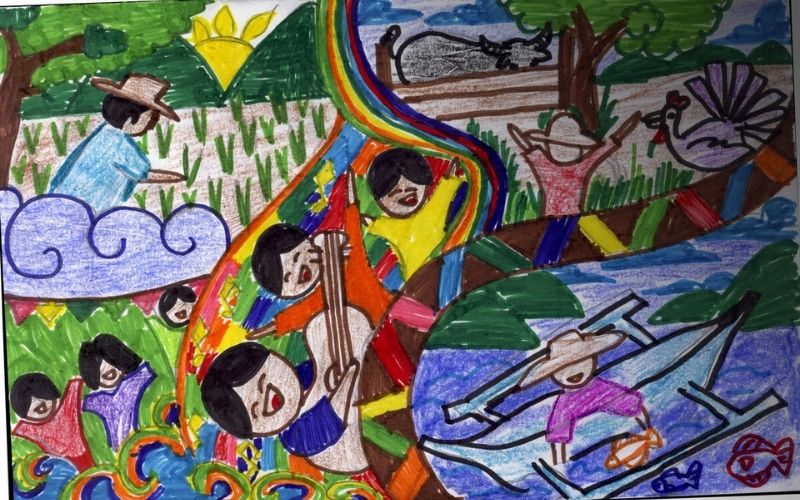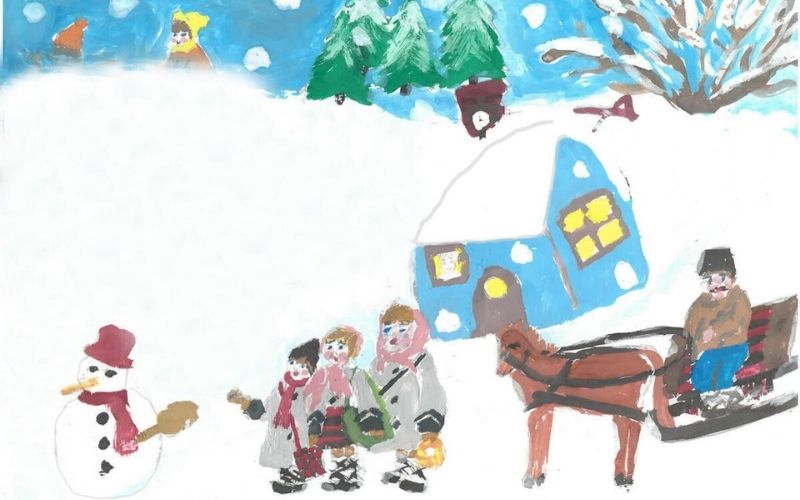Christmas can be a religious or cultural celebration … sometimes both. Just ask people in some 160 countries where the holiday is observed.
Come December, many nations are knee-deep in snow. Others are at the very height of summer. It all depends on which hemisphere you call home.
But no matter the reading on your thermometer, or your degree of religious faith, Christmas can be filled with immense wonder, cherished traditions – and a special sense of togetherness.
Are you ready for a Santa-paced tour around the world? In each country we visit, we’ll share what our World Vision staff have observed about Christmas celebrations there.
One holiday among many
At World Vision, we have the joy of serving in communities around the world, many of whom mark holidays other than Christmas.
Rosh Hashanah, Ramadan, Diwali and Vesak are just a few of the big days of the year for Jews, Muslims, Sikhs, and Hindus. Families may also celebrate local holidays, depending on their faith, culture, and region of the world.
But for today, we’ll touch down in communities getting ready for Christmas, to see what’s happening there. Our first stop … the Philippines!
 In the Philippines, 17-year-old Darrell has created a picture of celebration, joy, family and prosperity. Photo: Elissa Webster
In the Philippines, 17-year-old Darrell has created a picture of celebration, joy, family and prosperity. Photo: Elissa Webster
The Philippines: Four months of Christmas
Welcome to the heat of a Christmas in the Philippines. Because celebrations in this Southeast Asian country begin in the rainy season, they often kick off in a steamy 40 C.
“We have one of the longest Christmas celebrations in the world!” write the staff of World Vison Philippines. “The fun begins on September 1 and ends on the Epiphany, the first Sunday in January.
“Kids and adults traditionally go carolling, singing their hearts out. They play handmade instruments – drums made from milk cans and tambourines made from bottle tops.”
 In Romania, 14-year-old Miruna has drawn a photo of a family celebrating Christmas day. Photo: Elissa Webster
In Romania, 14-year-old Miruna has drawn a photo of a family celebrating Christmas day. Photo: Elissa Webster
Romania: Clean boots and ‘cozanaci’
Now to the Southeast European country of Romania, where temperatures often dip below freezing in December … and a night can be 16 hours long. No wonder the fun of the Christmas festivities begins weeks beforehand!
“Saint Nicholas is celebrated on December 6,” writes the staff of World Vision Romania. “We clean our boots and put them at the door before we go to sleep, hoping to wake up to find ‘Mos Nicolae’ has filled our shoes with sweets.
On Christmas Eve, women make ‘sarmale’ – a delicious meat-and-rice roll wrapped in cabbage and sauerkraut. It’s served with polenta, hot pepper, and sour cream. They also bake ‘cozonaci’ – a type of sponge cake with nuts, cocoa, and Turkish delight.
Christmas dinner highlights include roast pork, pickled vegetables, beef salad and homemade wine.”
 In Mali, families begin celebrating the birth of Jesus on Christmas Eve. Photo: Chris Huber
In Mali, families begin celebrating the birth of Jesus on Christmas Eve. Photo: Chris Huber
Mali: Praise and egg play
From here, we travel to the North African country of Mali, which also celebrates Christmas in its winter season. December temperatures are a comfortable average of 23 C … a good thing, too, given all the dancing!
“On Christmas Eve, Christians spend the night singing, dancing and praising God in churches,” write the staff of World Vision Mali. “Then, everyone – men, women, children – dresses up for Christmas and New Year celebrations, wearing colourful clothes and shoes.
“We cook delicious festive meals and visit our neighbours and relatives to share special greetings and blessings.
“Children also play special games including ‘dancing with an egg’. Each child holds an egg in their hand. They dance in a small, crowded circle so they don’t have enough space to dance easily. Everyone must dance and try not to drop their egg. The last child still holding an egg is the winner!”
 In Bolivia each January, children celebrate the arrival of the three kings to greet the baby Jesus. Photo: Jose Luis Roca
In Bolivia each January, children celebrate the arrival of the three kings to greet the baby Jesus. Photo: Jose Luis Roca
Bolivia: Mangers and fireworks
Hold on tight as we travel more than 7,000 kilometres over the Atlantic Ocean, to the South American country of Bolivia. We’ll cross the equator en route, landing in a Christmas average of 16 C.
“Christmas Day is filled with singing and dancing,” write the staff of World Vision Bolivia. “There are traditional dances and plays about the birth of Jesus. We build a manger like the one baby Jesus lay in, using mud, straw, stones, leaves, and branches, to celebrate His birth.
“On Christmas Eve, there are fireworks at midnight. On Christmas Day, we go to church, then eat a special meal of baked pig, or ‘picana’, a type of stew. After that, we join in local games and traditional dances.” – World Vision Bolivia.

In the Dominican Republic, 10-year-old Nerci has drawn a picture of a child celerbating Christmas, surrounded by decorations. Photo: Elissa Webster
Dominican Republic: sharing food and shining lights
Now north to the Dominican Republic, where countless Canadians have been blessed to spend Christmas over the years. No wonder. December is a beautiful average of 27 C … and full of life and colour.
“Every house is shining with different coloured lights,” write the staff of World Vision Dominican Republic. “We decorate our neighbourhoods with recycled things. There’s a lot of joy as people who live away return to their family home.
“We celebrate with dishes like rice with pigeon, peas, green salad, bread, pork, spaghetti, chicken, apples, grapes, pears, and candies. Some families save money in advance for this dinner, so we can share it with relatives and neighbours.”

In Armenia, 11-year-old Anahit has drawn a picture of the things she loves envisioning about Christmas.
Armenia: Red wine and burning lamps
Where did you stash your coat and hat? You’ll need them again. We’re headed to Armenia, where temperatures hover around 0 C for Christmas. Night in December is long and dark … just begging for traditional lanterns.
“The event ‘Chragaluits’, which means ‘burning lamps’, is a special mass held on Christmas Eve,” write the staff of World Vison Armenia. “People light a candle at church and bring it home to light the house and prepare for the Christmas feast.
“We invite guests to our house to eat fish, rice pilaf, dried apricots and raisins, and drink red wine. Each of these foods has special symbolism. The feasting goes all the way from December 31 to January 7!”

In Lesotho, children are up before the sun rises on Christmas morning, excited to greet the day. Photo: Ben Adams
Lesotho: Bright blankets and ‘bokos’
As my Christmas gift to you, we’ll finish our travels someplace warm … Lesotho in southern Africa. Families here celebrate in temperatures as warm as 25 C and many children greet the 5:20 a.m. sunrise on December 25.
“Our Christmas celebrations are loud and colourful!” write the staff of World Vision Lesotho. “Children wake in time to watch the sun come up, believing that those first rays will bring them joy as they attend church later in the morning.
“After church, children visit other families to get special Christmas ‘bokos’, Christmas treats like bread, cakes and drinks. Some children organize performances and go from place to place performing them.
“We wear our traditional patterned blankets, and the women dance the ‘Mokhibo’, moving their shoulders in time to the music while kneeling on the ground.”
The gifts of love and joy
Without the year-round care of donors in Canada, many families around the world may not be able to celebrate Christmas in quite the same way. You help increase their joy, in December and year-round.
On behalf of the children around the world you help care for – and from our family to yours – we wish you a peaceful, joy-filled holiday season.
Children all over the world celebrate Christmas. Learn more about different Christmas traditions in different countries.